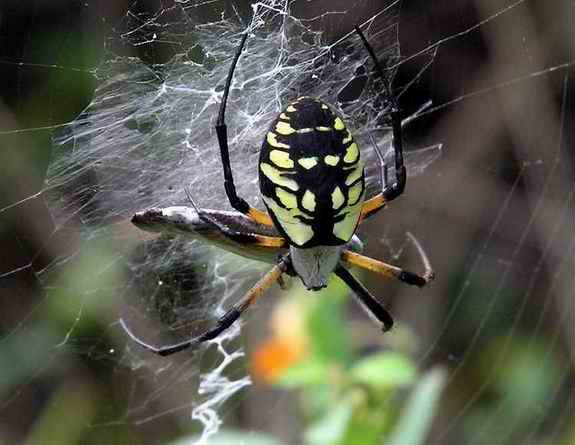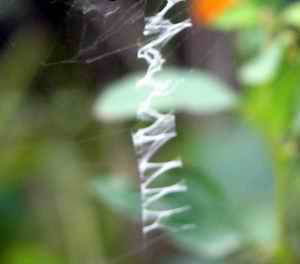|
Return to Hiker's Notebook Home Page
Common Name: Black and Yellow Orbweaver, Garden orbweaver, Black and yellow Argiope, Yellow garden spider, Banana spider, Golden orbweaver, Zipper spider, Writing spider - The spider weaves a circular web which is metaphorically like a flattened orb; the prosaic coloration of black and yellow is an added appellation to distinguish this species from other orbweavers.
Scientific Name: Argiope aurantia - Argiope was a Naiad or fresh water nymph in Greek Mythology who lived on Mount Parnassus and is known primarily as the mother of the Thracian bard Thamyris. The name means "of the silver face", the implication being that she was the Naiad of the "silvery" mountain stream. One of the species of the genus Argiope is called the silver orbweaver due to its "silver-faced" markings. The species name aurantia is from the New Latin aurantium which is derived from the Latin aurum, meaning gold. It is an alternative name for the Rutaceae Family of plants which includes lemon and orange trees. Its use in this application is to emphasize the bright colors of the spider.
The sharply contrasting colors of the Black and Yellow Argiope are its most conspicuous if confounding attribute. Predatory animals that use traps would logically rely on stealth to ensnare hapless victims and should therefore be chameleonic. The incongruous bright hues of the orbweavers were thought to be either for the attraction of a mate or as a means to divert predators. Many animals are aposematic; they indicate their toxicity with vibrant colors to provide an unambiguous signal to potential predators. The monarch butterfly and the red eft are two well known examples. However, recent research has demonstrated that the bright colors of the orbweavers may have another purpose, to attract prey to the web. It has been found experimentally that the brighter the colors, the more effective the trap. It is hypothesized that the bright colors of the spider resemble the flowers to which the insects are attracted for nectar extraction. Since orbweavers frequently are seen conspicuously affixed near the center of the web with no attempts at concealment, this theory has some credence.
The female Black and Yellow Argiope is about four times larger and about ten times heavier than the male, a condition known as sexual dimorphism. The spiders that are normally seen ensconced on the large orb-shaped webs are females; the smaller males usually have diminutive webs to the side. When the instinctual mating drive is manifest, the male approaches the female and waves his legs to encourage her assent to copulation. The male�s two sperm bearing organs are called pedipalps; they both must be inserted to consummate the mating process. When the second pedipalp is inserted, it swells to prevent removal and the male spider almost instantaneously dies, a behavior found in no other member of the animal kingdom. The male remains on the back of the female until she decides to break off the pedipalps so that the carcass can be removed, usually about thirty minutes after coitus. The body of the male is subsequently eaten by the female, not an uncommon trait of spiders. It is postulated that this rather unusual mating process evolved to prevent other males from copulating, thereby perpetuating the fatalistic trait through the resultant spiderlings. The mated female Black and Yellow Argiope will produce at least one but no more than three brown, paper-like egg sacks that each contains about 500 eggs. The egg sacks are anchored to the web and are suspended in a silk cocoon to protect against predation and incursion by alien species. Since the adult female spider dies with the first frost, the young are left to the serendipity of nature. The spiderlings hatch in late autumn but overwinter in the egg case by suspending their growth and development, a characteristic known as diapause. The effectiveness of the egg case as a haven in winter is evidenced by its use by other species; one study found that nineteen species of insects and eleven species of spiders emerged from the egg case of A. aurantia.
The web is an intricate construction that consists of radial non-sticky strands that extend from the center outward like the spokes of a wheel and orbital sticky strands that circle the hub in looping segmented spirals. The construction of the web starts with the ejection of a thread of silk from the spinnerets, the organs on the abdomen of the spider that control silk emissions. The free end of the silk thread drifts in the air until it encounters a distant object, thus establishing a bridge. From this foundation, temporary scaffolding is erected from which the radial and orbital strands are constructed. It takes two to three hours to complete the web, culminating with the consumption of the temporary scaffolding and the center of the hub. This process is often repeated nightly, the old web being eaten as raw material for its replacement, usually at the same location. The spider usually hangs head down near the center of the web, sensing the presence of prey from the vibrations of the web, as A. aurantia have very poor vision.
The web has a peculiar zigzag structure embedded in it that is called the stabilimentum, as it was originally thought that this was an engineering feature added to provide structural stability. This hypothesis is controversial. One alternative explanation is that these structures attract insects, the web material having an ultraviolet spectrum that is similar to flowers; however, it has been observed experimentally that hungry spiders build fewer stabilimenta and that their webs capture more prey. Another theory is that it is to deter birds from blundering into the web and destroying it. The Black and Yellow Argiope is also known as the Zipper Spider and the Writing Spider according to ones interpretation of the zigzag pattern of the stabilimentum.
That the orbweaver spider can traverse the sticky web strands capable of ensnaring insects twice its size without themselves becoming entangled is a matter of some interest. While it is occasionally posited that they exude a lubricant of some sort to offset the tenacity of the silk, it is the unique configuration of their walking claws that provides the mobility in the form of a small, strongly hooked third claw surrounded by bent, spiny hairs. When the spider walks on the web, the elastic spiny hairs bend and the third claw rotates forward to engage the thread. The elasticity and the reduced surface area of the spines afford a spring-like recoil to pull the leg away from the web.
Spider silk is an extraordinary substance. It is variously reported as being the strongest of all natural and man-made fibers: up to five times stronger than steel and twice as strong as Kevlar. However, since silk is an organic substance, it is highly hydrophilic, and any measurements must take into account the amount of moisture that it has absorbed. It's elasticity is highly dependent on the humidity, ranging from 30 to 300 percent elongation. Under test conditions that take moisture content into account, spider silk has a slightly lower tensile strength than steel for the same diameter thread; however, for equivalent weights, the spider silk is much stronger. When compared to Kevlar, spider silk is only one third as strong but five times more elastic. It is nonetheless remarkable that a natural material spun into fibers at ambient conditions compares favorably to highly engineered organic materials and metals.
Spiders in general and orbweavers in particular make as many as 8 different kinds of silk, though individual species usually use only 5 or 6 types. The silk is made up of proteinaceous liquids that are the product of one of six different kinds of specialized sac-like glands in the spider. Only the orbweavers have the aggregate gland that produces the sticky spirals of the orb and the flagelliform gland that produces the non-stick radii. Silk is secreted through ducts that lead to one of hundreds of spigots mounted on one of the (usually) six appendages called spinnerets. When the liquid leaves the spigot, it instantly solidifies and increases its molecular weight tenfold. The mechanics of this process are not yet understood, though it is thought to involve interaction between two different forms called α-chains and β-pleated sheets. Attempts at commercializing spider silk production are not practical. Spiders are very territorial and cannibalistic and would kill and eat each other before enough silk could be produced to be marketable. |

